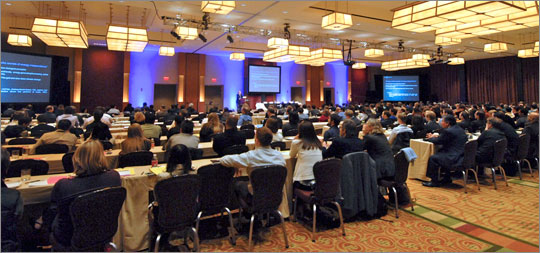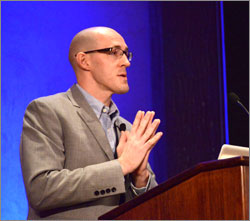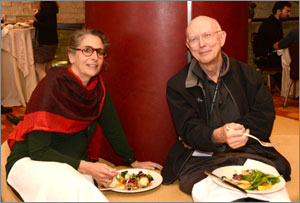The 4th annual “Wyss Retreat” held in Boston yesterday was not your typical academic meeting — but then again, the Wyss Institute isn’t a typical academic research institute.

“In just a few years, we’ve grown from nothing to something quite substantial, as you can see here today,” remarked Don Ingber, M.D., Ph.D., founding director of the Wyss, to a bustling crowd that filled the largest meeting room at the InterContinental Hotel. Since its inaugural year in 2009, the Institute — whose “high risk” research portfolio is aimed at transforming medicine and creating a sustainable environment — has grown to include more than 350 full-time staff, and the retreat audience has more than tripled from 140 to 460. The Wyss community as a whole is a dynamic mix of faculty, fellows, students, research and engineering staff, clinicians and industrial collaborators.

The meeting included a cornucopia of compelling updates on the Institute’s projects — from flying Robo-bees that could help in search and rescue missions, to a new way to assist children with cerebral palsy develop their muscles by “catching” butterflies on a Wyss-designed touchscreen computer, to human “organs-on-chips” that are designed to replace animal drug testing, to “out of the box” ways to sequence all of the products of the genome simultaneously within intact cells.
But this year’s meeting also focused heavily on translation. Translation is about how to take the projects out of the lab, and into the real world, and it is a core focus of the Wyss Institute.
This goal of spanning from advanced research to the commercialization of bioinspired materials and devices is what proudly makes the Institute unique: When you head into the Wyss, or participate in the retreat, you see entrepreneurs and business development experts working side-by-side with scientists and engineers in the lab, as well as with clinicians and industry leaders who know the market challenges first-hand. These interactions span innumerable fields; walls between disciplines simply don’t exist at the Institute.

“This year is going to be an exciting one because we’re very close to taking many of these technologies out the door,” said Ingber when referring to the ‘Institute Projects’ presentations that represent the Institute’s most advanced technologies. “And today you’re going to understand that each of our projects requires a different approach when it comes to commercialization — and each involves just as much passion and creativity as we [scientists] experience in the laboratory.”
Among the InstituteÕs more developed projects are a “smart” nanotherapeutic that selectively targets clot-busting drugs to vascular occlusion sites; a surface coating technology called SLIPS that repels just about anything, from preventing sticking of ice to airplane wings to stopping bacteria from growing on kitchen counters; and a pathogen capture technology that has been adapted for multiple applications, including devices for rapid diagnosis and treatment of patients with sepsis through efficient blood cleansing.
The list of honors and awards achieved over the past year by the Wyss faculty, students, fellows and staff, as well as the Institute itself, was so long that it was an impossible slide to read from the audience. But this seemed just fine to philanthropist and visionary Hansjorg Wyss, whose generous gift made the Wyss Institute possible. “This has been for me a terrific day,” said Mr. Wyss. “You are all proving that the things most people think can’t be achieved, can be done. …Keep going,” he said.